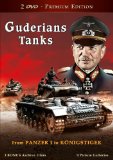![German U-Boats [DVD]](/pictures/1106897.jpg) German U-Boats | DVD | (28/07/2011)
from £6.98
| Saving you £10.00 (200.40%)
| RRP
German U-Boats | DVD | (28/07/2011)
from £6.98
| Saving you £10.00 (200.40%)
| RRP The North Atlantic was the main battlefield of the German submarines. From the beginning of 1942 the Anglo-American convoys ran on the northern route between Iceland and the ice-free Russian port of Murmansk and Archangelsk. The disruption or destruction of these huge supplies of materials was one of the main tasks of the German U - Boats. Aircraft Carriers Cruisers Destroyers Corvettes and countless smaller Patrol vessels were involved in battles in the Atlantic and the Arctic Ocean and played their part in the outcome of the fighting.
![German Tank Wars [DVD]](/pictures/1106900.jpg) German Tank Wars | DVD | (27/07/2011)
from £9.98
| Saving you £7.00 (87.61%)
| RRP
German Tank Wars | DVD | (27/07/2011)
from £9.98
| Saving you £7.00 (87.61%)
| RRP On the fronts were many different types of tanks assault guns and self-propelled guns in use. Light tanks of the type I and II medium tanks of the type III IV & PAN THER and the heavy battle tanks of the type: TIGER KNIGSTIGER etc. as well as numerous assault guns in different versions were in operation. The Tank divisions of the Wehrmacht and their support units came to use on all sections of the front. During the 1st World War tanks were used to support the infantry. They were linked on the battlefield with the slow infantry units to protect them and give them artillery support. The mass use of tanks gave a sinister influence on the outcome of events.
 Guderians Tanks - 2 DVD BOX | DVD | (13/06/2014)
from £11.98
| Saving you £20.00 (200.20%)
| RRP
Guderians Tanks - 2 DVD BOX | DVD | (13/06/2014)
from £11.98
| Saving you £20.00 (200.20%)
| RRP Heinz Guderian was the visionary, creator and designer behind many of Germany's most iconic Tanks. This brilliant strategist developed the attack tactics of the German Tanks Divisions. The key successes in the campaigns against Poland, France, the Balkans and, from 1941/42 in the Soviet Union and North Africa, can be credited to the Panzer troops set up by Guderian. From Panzer I, the King Tiger ( Tiger II ) and the Panther to the various assault guns, Tank Hunter vehicles and self propelled guns, these are just a small selection of the many fascinating Wehrmacht vehicles that feature in this film.
![German Battle Units [DVD]](/pictures/1111212.jpg) German Battle Units | DVD | (25/07/2011)
from £5.98
| Saving you £11.00 (275.69%)
| RRP
German Battle Units | DVD | (25/07/2011)
from £5.98
| Saving you £11.00 (275.69%)
| RRP After the British and French had declared war on the German Reich on the 3rd September 1939, the Western Front became a ghost front. It was only the start of the Western Campaign on 10th May 1940, that started the battles. The fast advance on Moscow in 1941, forced the German soldiers to bring tremendous march achievements. On dirt roads, often through boggy ground, the German troops pushed eastwards. The Wehrmacht soldiers had to cope with an enormous workload. According to the Versailles Treaty, Germany was only allowed to have an army of 100 000 men. This army, from 1919 until 1921, was referred to as the “Provisional Reichswehr”.
![German Main Battle Lines [DVD]](/pictures/1106899.jpg) German Main Battle Lines | DVD | (25/07/2011)
from £3.99
| Saving you £11.00 (275.69%)
| RRP
German Main Battle Lines | DVD | (25/07/2011)
from £3.99
| Saving you £11.00 (275.69%)
| RRP During the year 1942 according to information from England about 1000 attacks were flown on German territory including 17 heavy attacks with a quantity of more than 500 tons of bombs and incendiary's. In 1944 this figure increased almost fivefold to about 1.6 million tons. The German arms industry was not crucial affected by these attacks on the contrary in December 1944 the monthly output reached its absolute peak. In 1944 the Wehrmacht was on the retreat on all fronts. Gradually the main battle lines moved ever closer to the Reich.

Please wait. Loading...
This site uses cookies.
More details in our privacy policy